
Tiberinus is a figure in Roman mythology. He was the god of the Tiber River. He was added to the 3,000 rivers (sons of Oceanus and Tethys), as the genius of the Tiber.

Tiberinus is a figure in Roman mythology. He was the god of the Tiber River. He was added to the 3,000 rivers (sons of Oceanus and Tethys), as the genius of the Tiber.
According to Book VIII of Virgil's epic Aeneid , Tiberinus helped Aeneas after his arrival in Italy from Troy, suggesting to him that he seek an alliance with Evander of Pallene in the war against Turnus and his allies (see founding of Rome). Tiberinus appeared to Aeneas in a dream, telling him he had arrived at his true home. Tiberinus also calmed the water so that Aeneas' boat was able to reach the city safely. [1] With Manto, Tiberinus was the father of Ocnus. [2]
According to Livy, author of Ab Urbe Condita, the first name of the river Tiber was Albula, and Tiberinus was one of the kings of Alba Longa, who drowned in crossing this river, and gave the river his name. [3]
Tiberinus is also known as the river god who found the twins Romulus and Remus and gave them to the she-wolf Lupa (who had just lost her own cubs) to suckle. He later rescued and married Rhea Silvia, the mother of the twins and a Vestal Virgin who had been sentenced to death. [4]
Tiberinus was considered to be one of the most important river-gods and people made sure to put offerings in the Tiber River every May. Tiberinus was honored with twenty-seven straw dummies which were called Argei . [5]

In Greco-Roman mythology, Aeneas was a Trojan hero, the son of the Trojan prince Anchises and the Greek goddess Aphrodite. His father was a first cousin of King Priam of Troy, making Aeneas a second cousin to Priam's children. He is a minor character in Greek mythology and is mentioned in Homer's Iliad. Aeneas receives full treatment in Roman mythology, most extensively in Virgil's Aeneid, where he is cast as an ancestor of Romulus and Remus. He became the first true hero of Rome. Snorri Sturluson identifies him with the Norse god Víðarr of the Æsir.
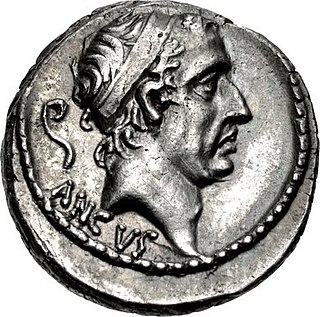
Ancus Marcius was the legendary fourth king of Rome, who traditionally reigned 24 years. Upon the death of the previous king, Tullus Hostilius, the Roman Senate appointed an interrex, who in turn called a session of the assembly of the people who elected the new king. Ancus is said to have ruled by waging war as Romulus did, while also promoting peace and religion as Numa Pompilius did.
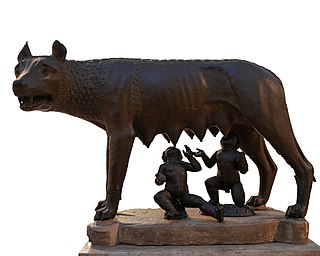
In Roman mythology, Romulus and Remus are twin brothers whose story tells of the events that led to the founding of the city of Rome and the Roman Kingdom by Romulus, following his fratricide of Remus. The image of a she-wolf suckling the twins in their infancy has been a symbol of the city of Rome and the ancient Romans since at least the 3rd century BC. Although the tale takes place before the founding of Rome around 750 BC, the earliest known written account of the myth is from the late 3rd century BC. Possible historical bases for the story, and interpretations of its local variants, are subjects of ongoing debate.

Latinus was a figure both in Greek and Roman mythology. He is often associated with the heroes of the Trojan War, namely Odysseus and Aeneas. Although his appearance in the Aeneid is irreconcilable with his appearance in Greek mythology, the two pictures are not so different that he cannot be seen as one character.
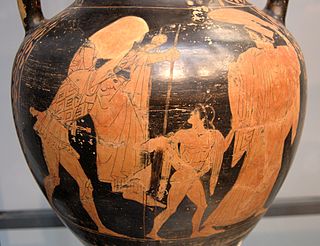
Ascanius was a legendary king of Alba Longa and is the son of the Trojan hero Aeneas and Creusa, daughter of Priam. He is a character in Roman mythology, and has a divine lineage, being the son of Aeneas, who is the son of the goddess Venus and the hero Anchises, a relative of the king Priam; thus Ascanius has divine ascendents by both parents, being descendants of god Jupiter and Dardanus. He is also an ancestor of Romulus, Remus and the Gens Julia. Together with his father, he is a major character in Virgil's Aeneid, and he is depicted as one of the founders of the Roman race.

In Roman mythology, Evander was a culture hero from Arcadia, Greece, who was said to have brought the pantheon, laws, and alphabet of Greece to ancient Italy, where he founded the city of Pallantium on the future site of Palatine Hill, Rome, sixty years before the Trojan War. He instituted the festival of the Lupercalia. Evander was deified after his death and an altar was constructed to him on the Aventine Hill.
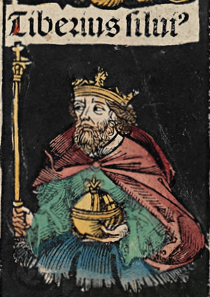
Tiberinus was the ninth king of Alba Longa, according to the traditional history of Rome handed down by Titus Livius. He was the successor of Capetus, the eighth king of Alba Longa. The Alban kings claimed descent from Aeneas, a Trojan prince who brought a remnant of the Trojan populace to Italy following the sack of Troy, and settled in Latium. Alba was built by Ascanius, the son of Aeneas and Lavinia, and founder of the Alban royal line. The Alban kings, including Tiberinus, bore the cognomenSilvius, after the son of Ascanius, who was said to have been born in the woods.

In Roman mythology, Faustulus was the shepherd who found the infant Romulus and his twin brother Remus along the banks of the Tiber River as they were being suckled by the she-wolf, Lupa. According to legend, Faustulus carried the babies back to his sheepfold for his wife Acca Larentia to nurse them. Faustulus and Acca Larentia then raised the boys as their own. Romulus later defeated and killed King Amulius of Alba Longa, with the help of Faustulus, and his brother Pleistinus. Romulus and Remus set out to build their own city, but then had a falling out. In the ensuing skirmish, Faustulus and Pleistinus were killed. Romulus went on to found Rome
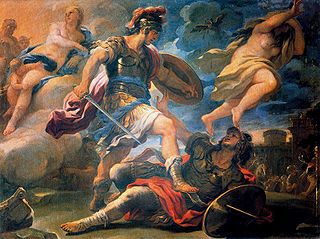
Turnus was the legendary King of the Rutuli in Roman history, and the chief antagonist of the hero Aeneas in Virgil's Aeneid.

In Roman mythology, Lavinia is the daughter of Latinus and Amata, and the last wife of Aeneas.

RheaSilvia, also known as Ilia, was the mythical mother of the twins Romulus and Remus, who founded the city of Rome. This event was portrayed numerous times in Roman art Her story is told in the first book of Ab Urbe Condita Libri of Livy and in Cassius Dio's Roman History. The Legend of Rhea Silvia recounts how she was raped by Mars while she was a Vestal Virgin, resulting in the twins, as mentioned in the Aeneid and the works of Ovid.

In Roman mythology, King Numitor of Alba Longa was the maternal grandfather of Rome's founder and first king, Romulus, and his twin brother Remus. He was the son of Procas, descendant of Aeneas the Trojan, and father of the twins' mother, Rhea Silvia, and Lausus.a

The Aventine Hill is one of the Seven Hills on which ancient Rome was built. It belongs to Ripa, the modern twelfth rione, or ward, of Rome.
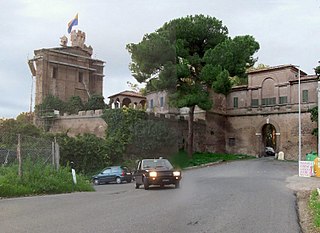
Lavinium was a port city of Latium, 6 km (3.7 mi) to the south of Rome, midway between the Tiber river at Ostia and Antium. The coastline then, as now, was a long strip of beach. Lavinium was on a hill at the southernmost edge of the Silva Laurentina, a dense laurel forest, and the northernmost edge of the Pontine Marshes, a vast malarial tract of wetlands. The basis for the port, the only one between Ostia and Antium, was evidently the mouth of the Numicus river.

In Roman legend, Tarpeia, daughter of the Roman commander Spurius Tarpeius, was a Vestal Virgin who betrayed the city of Rome to the Sabines at the time of their women's abduction for what she thought would be a reward of jewelry. She was instead crushed to death by Sabine shields and her body cast from the southern cliff of Rome's Capitoline Hill, thereafter called after her the Tarpeian Rock.
The Rutuli or Rutulians were an ancient people in Italy. The Rutuli were located in a territory whose capital was the ancient town of Ardea, located about 35 km southeast of Rome.

The kings of Alba Longa, or Alban kings, were a series of legendary kings of Latium, who ruled from the ancient city of Alba Longa. In the mythic tradition of ancient Rome, they fill the 400-year gap between the settlement of Aeneas in Italy and the founding of the city of Rome by Romulus. It was this line of descent to which the Julii claimed kinship. The traditional line of the Alban kings ends with Numitor, the grandfather of Romulus and Remus. One later king, Gaius Cluilius, is mentioned by Roman historians, although his relation to the original line, if any, is unknown; and after his death, a few generations after the time of Romulus, the city was destroyed by Tullus Hostilius, the third King of Rome, and its population transferred to Alba's daughter city.

Romulus was the legendary founder and first king of Rome. Various traditions attribute the establishment of many of Rome's oldest legal, political, religious, and social institutions to Romulus and his contemporaries. Although many of these traditions incorporate elements of folklore, and it is not clear to what extent a historical figure underlies the mythical Romulus, the events and institutions ascribed to him were central to the myths surrounding Rome's origins and cultural traditions.

Alba Longa was an ancient Latin city in Central Italy in the vicinity of Lake Albano in the Alban Hills. The ancient Romans believed it to be the founder and head of the Latin League, before it was destroyed by the Roman Kingdom around the middle of the 7th century BC and its inhabitants were forced to settle in Rome. In legend, Romulus and Remus, founders of Rome, had come from the royal dynasty of Alba Longa, which in Virgil's Aeneid had been the bloodline of Aeneas, a son of Venus.